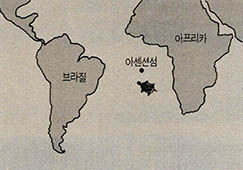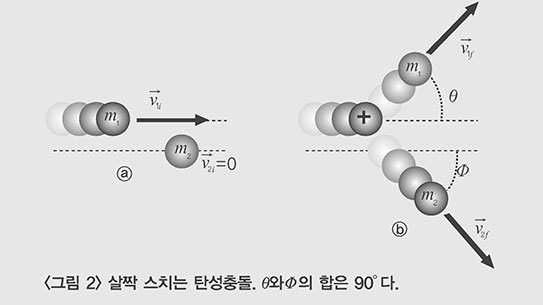
과학적인 조사가 항상 진실을 얘기할 수는 없는 노릇이지만 때로 극적이고 훌륭하게 보이는 것이 진실이 아닌 것으로 드러난다. 그런 사례의 하나가 1989년초 녹색거북과 관련해서 생겼다.
많은 동물들이 규칙적으로 이동한다. 한 장소에서 번식하고 수천 마일이나 떨어지기도한 다른 장소에서 서식한다. 이것은 자신이 가진 감각과 본능이외에는 아무런 도움없이 긴 여정을 찾아 나서야 함을 뜻한다.
예컨대 녹색거북은 브라질의 해변에서 번식하고 매해 연말쯤에는 무언가에 이끌리듯 동쪽으로 향한다. 대서양을 횡단, 두달이나 여행을 한다. 그들은 마침내 브라질에서 1천2백마일이나 떨어진 대서양 중간의 작은 땅덩어리인 아센션섬의 해안에 도착한다. 그곳에서 둥지를 만들고 번식하며 다시 브라질로 돌아가서(또 두달에 걸친 1천2백마일의 여행) 생활한다.
아셈션섬에서 부화되고 살아남은 새끼거북들도 브라질로 헤엄쳐 건너오지만 연말에는 다시 건너가는 것이다.
실제 동물세계에서 번식하려 할 때 태어난 곳으로 돌아가려고 긴여행을 하는 일은 흔한 것이다. 이것을 '출생귀소'라고 한다.
생물학자들은 이 동물들이 어떻게 항행(航行)을 할 수 있는지 궁금해 하지만 정말 그들을 당혹케 하는 것은 왜 그런 귀소행위를 하는가 하는 점이다.
왜 거북이는 그렇게 먼 여행을 하여야 하나? 다른 장소가 지니지 못한 것을 아센션섬이 지니고 있을까? 실제로 몇몇의 녹색 거북이는 다른 곳에 보금자리를 짓는다. 플로리다와 베네주엘라에도 한 장소씩 있지만 아센션 섬이 가장 일반적이다. 1974년에 플로리다의 두 생물학자, '패트릭 콜만'과 '아치 카아'는 재미있는 가정을 하였다. 아센션 섬은 4천만년 전에는 아프리카와 남아메리카가 거의 붙어 있던 곳이 중부 대서양 해령과 매우 근접해 있다. 당시에 녹색 거북은 브라질에서 몇 마일 떨어진 아센션 섬으로 헤엄쳐 가서 번식하였을 것이다.
하지만 해령으로부터 물질들이 스며나와 땅덩이들을 서로 떨어지게 해(해저확장) 대서양이 형성되고 있었다. 브라질의 서식장소는 해령과 아센션 섬으로부터 매년 조금씩 멀어져 갔고 거북이들은 아센션 섬으로 조금씩 더 헤엄쳤다. 거북이는 해변이 더 멀어졌다는 어떠한 느낌도 가져 보지 못하였지만, 4천만년 후에는 매번 1천2백마일을 여행하게 되었다.
해저의 확정이 거북이를 우롱한다는 가능성은 상당히 극적이 요소들이 있어서 이 가정을 믿으려는 경향이 강했지만, 하버드 대학의 '스테픈 제이 굴드'는 회의론자 중의 한 명이었다. 아센션 섬에 해변이 없었거나, 수백년 동안 일시적으로 파도 아래에 잠겨있었을 시기가 4천만년 동안에 반드시 있었을 것이라고 그는 말했다. 그렇다면, 앞의 얘기는 깨어질 수 있다.
녹색 거북이가 아센션 섬을 4천만년 동안 방문하였는가, 아닌가를 시험하거나 확인할 방법이 있을까?
조지아 대학의 두 과학자, '브라이언 C.보웬'과 '존 C.어바이스'는 플로리다 해양연구소의 '앤 E.메일란'과 함께 거북이 세포 미토콘드리아의 핵산 분자를 조사하여 왔다.
이것들은 세대를 걸쳐서 유전되며 해를 거듭하면서 천천히 변한다.(이것이 바로 진화를 가능케 하는 것이다) 아센션 섬을 방문하는 거북이의 핵산은 천천히 변하였고 플로리다와 베네주엘라에 보금자리를 마련하는 거북이의 경우도 마찬가지였다.
하지만, 만약 거북이가 수천만년 동안 자신들이 번식한 곳에 항상 눌러 붙어 있었다면 각 집단의 변화하는 다른 모양으롤 진행되었을 것이고 지금쯤 세 집단의 핵산은 상당히 다를 것이다. 현대의 과학자들은 핵산이 얼마나 다른가를 설명할 방법을 알고 있다.
세 집단 사이에 실제로 차이가 존재한다는 것이 판명되었지만 수천만년 동안 불리되어 있었다고 기대하기에는 훨씬 작은 차이였다. 그 차이는 4천만년이 아니라 고작 4만년의 분리를 가정할 수 있는 크기였다.

이것으로부터 두가지 가능성이 떠오른다. 한 경우에 있어서, 귀소(歸巢)본능은 결국 확실한 것이 못된다. 어떤 약간의 거북이들이 혼동되어서 잘못된 해변에 이르렀다. 그들은 거기에 있던 거북이들과 짝을 짓고 핵산을 혼합한다. 이런 종류의 적은 정도의 '누출'조차도 대부분의 차이를 지울 수 있다.
다른 가능성은 일반적으로 거북이들이 우리 생각보다 더 적응성이 있다는 것이다. 4천만년전에 약간의 거북이가 아센션 섬 해변을 우연히 발견하였다. 우리 모두가 아는 것 처럼, 이섬은 그때 바로 전에 형성되었을 수도 있고 전에는 없었거나 단지 오랜 간격을 두고 존재하였을 수도 있다. 이 거북이들이 그곳을 차지하여 지금까지 사용하고 있는 동안 다른 거북이들은 다른 장소를 사용하였다.
과학자들이 어떻게든지 아센션 섬이 4천만년 동안 끊임없이 존재했는가의 여부를 결정할 수 있다면 그들이 녹색 거북이의 행동에 관한 이론중 어느 것이 옳은가를 결정하는데 도움이 될것이다. 그러나 섬이 물 속에 가라앉은 기간이 존재했을 것이고 거북이가 실제로 적응력이 있다는 것이 가능성이 있어 보인다.
그리고 어느날 아센션 해변을 사용하지 못하게 될 때 거북이들은 다른 곳으로 이동할지 모른다. 덜 극적인 이론이, 아마도 더 사리를 갖춘 이론인 것 같다.
Scientific investigation can't always tell you exactly what is true, but some-times it can tell you that something that is dramatic and sounds good may not be true. That Happened early in 189 in connection with, of all things, green turtles.
Many animals routinely migrate, breeding in one place and feeding in another place that may be thousands of miles away. This means they must find their way from one place to the other without benefit of anything more than their senses and their instincts.
Green turtles, for instance, feed along the shores of Brazil, but toward the end of each year, something drives them eastward across the Atlantic Ocean on a journey that takes them tow months. They finally end up on the beach of Ascension Island, a small bit of land in the mid-Atlantic about 1,200 miles east If Brazil. There they nest and breed, and them return(another 1,200 miles, another two months to Brazil to feed.
The little turtles that hatch out on Ascension Island, and survive, also swim back to Brazil, only to return at the end of the year. Actually, it is common for animals to travel long distances to return to the place where they were born, when they want to breed ; it's called "natal homing." Biologists speculate on just how these animals manage the navigation, but what really puzzles them is, why?
Why should turtles make such a long journey? What has Ascension Inland got that other places don't have? Actually,some green turtles do nest in other places. There's one place off Florida and one off Venezuela, but Ascension Island is the most popular.
Back in 1974, Patrick Coleman and Archie Carr, two Florida biologists, made an interesting suggestion. Ascension Island is very close to the Mid-Atlantic Ridge, where, some 40 million years ago, Africa and South America nearly touched. In those days, green turtles would feed off Brazil Island and breed.
However, the Atlantic Ocean was forming, because material was oozing up from the ridge and forcing the land masses apart ("sea-floor spreading"). Every year, the feeding grounds off Brazil were an inch or so farther away from the ridge and from Ascension Island. Every year, the turtles swam an additional inch to get to the Ascension beaches. At on time did the turtles have any sense that the beach was perceptibly farther away, but after 40 mil-lion years, they were making a 1,200 mile trip each way.
There's something so dramatic about the possibility of sea-floor spreading fooling the turtles that there was a strong tendency to believe the suggestion but Stephen jay Gould of Harvard was one skeptic. He said that in 40 million years there must have been times when Ascenion Island had no beaches or when it may even have been temporarily beneath the waves for a few hundred tears. That would have broken the spell.
Is there any way of testing the matter and of seeing whether the green turtles have been visiting Ascension Island for 40 million years-or not?
Tow scientists at the University of Georgia, Brian W. Bowen and John C. Avise, along with Anne B. Meylan of the Florida Institute of Marine Research, have been checking the nucleic acid molecules in the miotchondria of turtle cells.
These are inherited through the generations and slowly change with the tears (that's what makes evolution possible). The turtles that visit Ascension have nucleic acids that slowly changed, and so do the turtles that nest off Florida and those that nest off Venezuela.
If, however, the turtles have always clung to their breeding grounds for tens of millions of years, each group would have undergone a different set of changes and the three sets of mucleic acids ought now to be far apart. Scientists nowadays have ways of telling how far apart they ought to be.
Differences did indeed turn out to exist among the three groups, but they were far smaller than would be expected of a multi-million-year separation. The difference was of a size that suggested a separation of only 40,000 years rather than 40 million.
That gives rise to two possibilities. In one case, the homing instinct isn't infallible after all, the homing instinct isn't infallible after all. A certain small fraction of turtles get confused and end up at the wrong beaches. They breed and mix their nucleic acids with those who belong there. Even a small rate of "leakage" of this sort would wipe out most of the difference.
The other possibility is that turtles in general are more flexible that we think. Forty thousand years ago, some may have accidentally discovered the Ascension Is-land beaches, which, for all we know, may have just formed then and may not have existed before, or existed only at long intervals, These turtles colonized at long intervals, These turtles colonized them and used them ever since, while other turtles used other beaches.
If scientists could somehow determine whether Ascension Island has been in uninterrupted existence for 40 million years, that would help them determine which theory of the green turtle's behavior is correct. But it seems probable that there would have been times when the island was submerges, and that the turtles are indeed flexible.
And if, someday, the Ascension beaches become unusable, the turtles may shift to others. A less dramatic theory, perhaps-but more sensible.
(c) 1989, Los Angles Times Syndicate

















